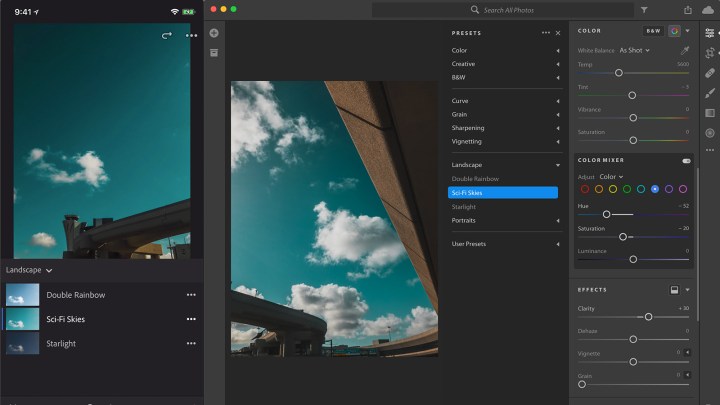
Lightroom’s cloud-based structure is designed to easily sync photo libraries between multiple devices — and now, editing presets and profiles will sync across devices as well. The Lightroom CC update comes as part of a longer list of Adobe updates unveiled on Tuesday, June 19, including the arrival of Spark Post on Android and updates to Adobe XD.
Synced presets across desktop and mobile
Lightroom CC users can now use the same presets between desktop and mobile. Presets imported through the desktop version will now sync via the cloud to the iOS and Android mobile apps. The same synchronization also works with color profiles, a newly refreshed feature from Lightroom’s last update. The new feature works with both purchased third-party presets and user-generated presets.
To sync the presets, users need to follow the same steps for importing a preset on Lightroom CC (not Lightroom Classic) and choose the “import profiles and presets” option. Once imported, new presets will automatically appear on other devices using the same account.
The update also brings the ability to create presets in the mobile apps. Like on the desktop, the mobile app uses the edits already applied to the selected photo to create a new preset. Users can select which adjustments to include in the preset.

Batch editing is also coming to the newer version of Lightroom. In desktop versions of Lightroom CC, adjustments can now be copied and pasted to multiple images at once. Previously, adjustments could only be pasted to individual images.
While batch editing remains exclusive to the desktop at this time, the mobile version is inheriting the healing brush tool. The iOS app also gains a tool for removing chromatic aberrations, the color fringing often found on high contrast edges.
Adobe is also bringing beta tested tools to both mobile apps through Technology Previews. If Technology Previews are enabled in the app settings, iOS users will see a long exposure mode on the built-in camera that doesn’t require a tripod. The mode blends multiple short exposures to create the motion blur of a slower shutter speed. iOS is also gaining Guided Tutorials through the Technology Preview feature, while Android users can try out an Expanded HDR mode on devices for which Adobe hasn’t yet certified the feature.
Lightroom Classic gains more organization tools
Lightroom Classic wasn’t left out of the update spree, either. With the June update, users will find additional tools to sort through presets and profiles, including collapsing profiles and hiding some from view. Searching within a folder is now faster, while folders can also be labeled with colors. When working with HDR and panoramas, Lightroom Classic will automatically stack the photos together, hiding unedited photos from the view. (The stack option can be turned off with a simple checkmark).
Spark Post debuts on Android

Spark Post is Adobe’s app for designing social media posts using photos, text, and templates, but even after renaming the app in 2015, Adobe has kept the app iOS only. That’s changing, however, with an Android version on today’s list of announcements. The app is still in beta, but it’s the first public launch of the app on
Adobe says Spark Post for Android makes it possible to create the same graphics as on iOS, with access to the same templates, designs, fonts, shapes, filters, and tools.
The app is an extension of the online version of Spark, Adobe’s tool for quickly creating simplified graphics. As a beta version, Adobe is still working out some of the experience, but the app is available to Android users publicly for the first time as a download from the Google Play Store.
Adobe XD sees new overlays and fixed elements
Lastly, Adobe XD, the company’s UX design tool for imagining apps and websites, also sees a handful of updates. The software now has fixed elements, which locks an object in place. For example, a fixed menu bar will stay on the same spot in the screen even while scrolling. Also included is a beta test of an option to share projects privately via email, along with enhancements to cropping and image fills.
The XD update comes on the heels of Adobe launching a free version of the software, with additional sharing options for subscribers.



